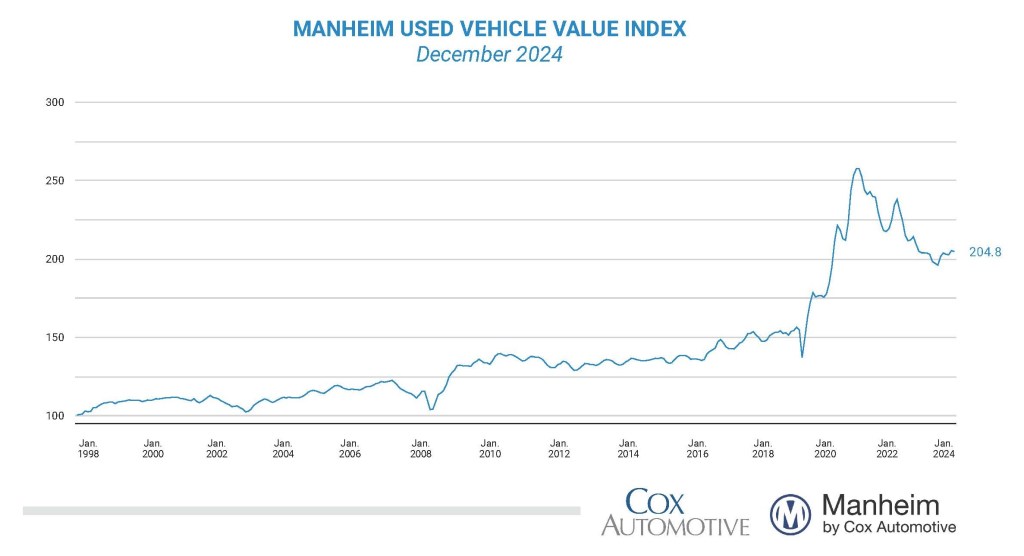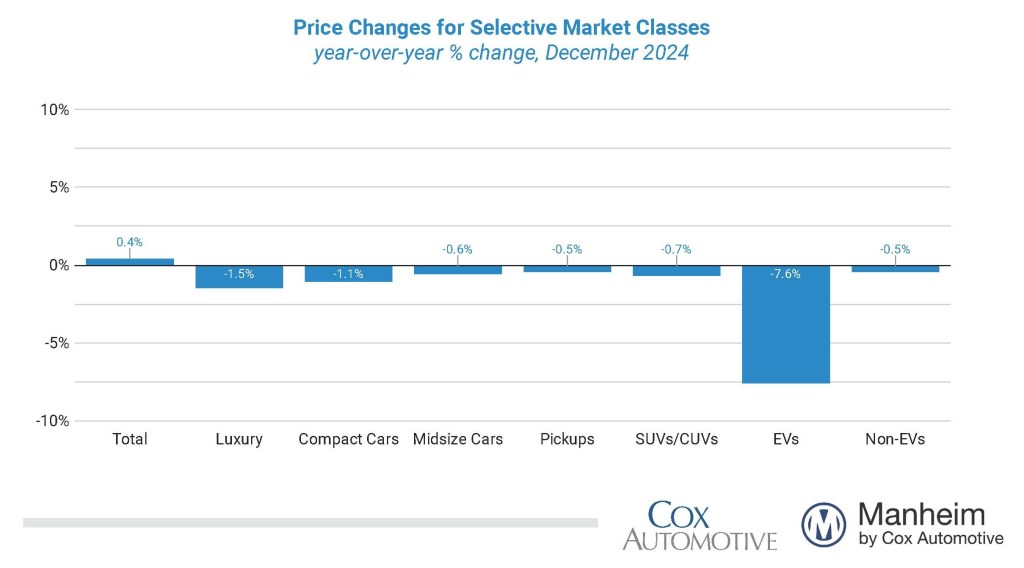Data Point
Wholesale Used-Vehicle Prices Decreased in December
Wednesday January 8, 2025
Wholesale used-vehicle prices (on a mix, mileage, and seasonally adjusted basis) were lower in December compared to November. The Manheim Used Vehicle Value Index (MUVVI) fell to 204.8, an increase of 0.4% from a year ago. The seasonal adjustment to the index reduced the change for the month, as non-seasonally adjusted values declined at a higher rate. The non-adjusted price in December decreased by 0.8% compared to November, moving the unadjusted average price up 0.3% year over year.

“On the margin, wholesale values declined just a bit more than usual right at year-end; but when all was said and done, it was our most normal year for depreciation trends in the last five years,” said Jeremy Robb, senior director of Economic and Industry Insights at Cox Automotive. “The Manheim Index ended the year up 0.4% from last year, below the long-term average increase of 2.3%. Market participants experienced a bit of a roller coaster ride, with values depreciating more than normal in the first half but less in the second half, and we ended the year much closer to longer-term trends. With the tightness of current retail supply, lower lease maturities expected throughout the coming year, and the question of tariffs on new vehicles still up in the air, we expect to continue to see more normal depreciation patterns in 2025.”
In December, Manheim Market Report (MMR) values saw weekly decreases in every week of the month, with larger declines seen in the back half of the month, consistent with seasonal trends. Over the last four weeks, the Three-Year-Old Index decreased an aggregate of 1.3%, including a decline of 0.5% in each of the last two weeks of December. Those same four weeks delivered an average accumulated decrease of 0.5% between 2014 and 2019, indicating depreciation trends were a bit higher than we usually experience right at year-end.
Over the month, daily MMR Retention, which is the average difference in price relative to the current MMR, averaged 99.1%, meaning market prices moved away from MMR values this month and were lower against November levels. Compared to last year, valuation models were higher by 1.3 percentage points for MMR retention but six-tenths of a point higher than 2019 levels for the same period. The average daily sales conversion rate fell to 53.8%, a decline of 1.1 percentage points against last month, yet higher than we normally see at this time of year. For comparison, the daily sales conversion rate averaged 51.9% in December over the last three years. Given the holiday period and the impact on sales and offerings, it is normal to see a seasonal decline in conversion in December.
All major market segments experienced seasonally adjusted prices that were down year over year in December, though the declines have been mitigated in recent months. Compared to December 2023, trucks were down the least, falling by 0.5% in the period, with mid-size sedans falling 0.6% and SUVs down 0.7%. Compact cars fell by 1.1% over the period, and luxury performed the worst, falling 1.5% against last year. Compared to the previous month, the truck segment outperformed the industry overall, rising by 1.0% over the month, while compact cars fell by 0.3%, which aligns with the industry average. The luxury segment fell 0.5% against November 2024, SUVs declined 0.7%, and mid-size sedans showed the highest decline, falling by 0.9%.

Looking at the market by powertrain, electric vehicles (EVs) were higher against November and stronger than the industry average overall, increasing by 3.4%, while non-EVs fell 0.5% over the same time. Seasonally adjusted EV values for December 2024 continued to show stronger depreciation trends, though the year-over-year declines have slowed in the last few months, with values falling by 7.6%. Non-EVs were down only 0.5% year over year, a bit higher than the overall industry average.
Retail Used-Vehicle Sales Were Flat in December
Assessing retail vehicle sales based on observed changes in units tracked by vAuto, we initially estimate retail used-vehicle sales in December were flat compared to November and higher year over year by 13%. The average retail listing price for a used vehicle increased 0.3% over the last four weeks.
Using estimates of retail used days’ supply based on vAuto data, an initial assessment indicates December ended at 48 days’ supply, up one day from 47 days at the end of November and down 10 days from December 2023 at 58 days.
New-vehicle sales in December were up 2.0% from last year, and volume increased 8.4% from November. The December sales pace, or seasonally adjusted annual rate (SAAR), came in at 16.8 million, up 0.9 million from last year’s pace and higher than November’s upwardly revised 16.6 million level.
Combined sales into large rental, commercial, and government fleets decreased 11.6% year over year in December. Including an estimate for fleet deliveries into dealer and manufacturer channels, the remaining new retail sales were estimated to be up 2.1% from last year, leading to an estimated retail SAAR of 14.0 million, up 6.3% from last year’s pace and up from November’s estimated 13.7 million level. Fleet share was estimated to be 13.3%, down from last year’s 14.1% share.
Rental Risk Price and Mileage Results Were Mixed Against Last December
The average price for rental risk units sold at auction in December decreased 0.1% year over year. Rental risk prices also fell by 2.6% compared to November. Average mileage for rental risk units in December (at 51,700 miles) rose 12.3% for the month against last year’s level. For the month of December, the average mileage of the rental unit was also higher, by 6.1% from November 2024.
Measures of Consumer Confidence Were Mixed in December
The Conference Board Consumer Confidence Index® declined 7.2% in December, which was far worse than the small gain expected; but November’s index was revised higher. Consumers’ views of both the present and the future declined, with the view of the future plunging 13.4% to its lowest level since July. Consumer confidence was down 3.1% year over year. Plans to purchase a vehicle in the next six months also dropped to the lowest level since June from what had been the highest level since May 2019, leaving plans down year over year for the first time in four months. The sentiment index from the University of Michigan increased 3% in December, which was lower than expected as it saw no improvement from the earlier reading at the beginning of the month. With the final monthly increase, the index was up 6.2% year over year. The underlying views of current conditions and future expectations moved in different directions, with current conditions jumping but consumer expectations falling. Expectations for inflation in one year increased to 2.8% from 2.6%, but expectations for inflation in five years declined to 3.0% from 3.2%. Consumers’ views of buying conditions for vehicles increased to the best level since April as views of interest rates were less negative, but the views of prices deteriorated. The daily index of consumer sentiment from Morning Consult saw a slight increase in December after increases in each of the prior five months. The index was up 0.1% for the month, which left the index up 10.4% year over year. According to AAA, the national average price for unleaded gas was $3.06 per gallon, up 0.4% in December from the end of November but down 1% year over year.
The quarterly call will be held on Wednesday, Jan. 8, 2025, at 11 a.m. EST. Register to attend.
For questions or to request data, please email manheim.data@coxautoinc.com. If you want updates about the Manheim Used Vehicle Value Index, as well as direct invitations to the quarterly call sent to you, please sign up for our Cox Automotive newsletter and select Manheim Used Vehicle Value Index quarterly calls.
Note: The Manheim Used Vehicle Value Index was adjusted to improve accuracy and consistency across the data set as of the January 2023 data release. The starting point for the MUVVI was adjusted from January 1995 to January 1997. The index was then recalculated with January 1997 = 100, whereas prior reports had 1995 as the baseline of 100. All monthly and yearly percent changes since January 2015 are identical. Learn more about the decision to rebase the index.
